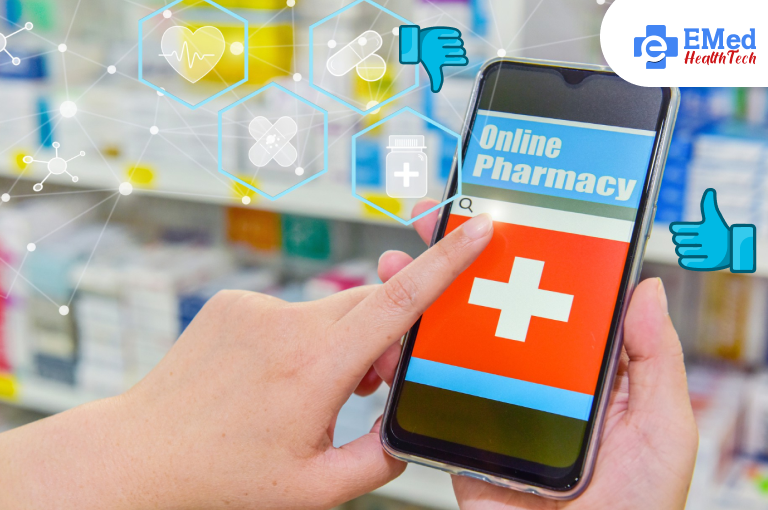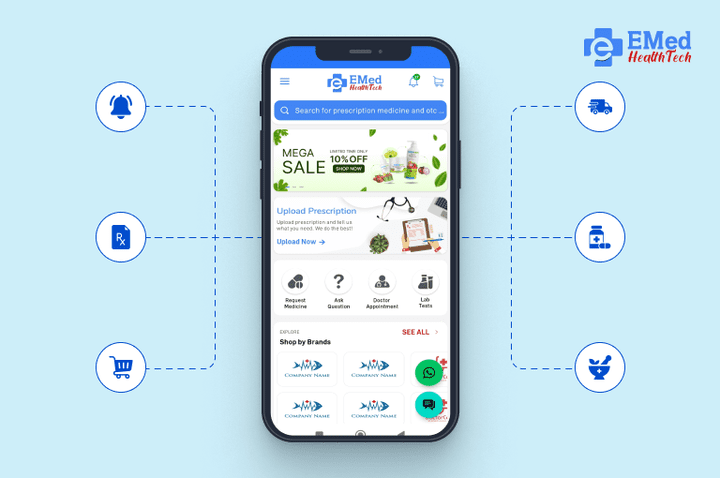Salim Chauhan
Convenience is now the primary component of almost all services in the digital era, including healthcare. The online pharmacy app, which lets users purchase drugs from the comfort of their homes, is one of the most revolutionary technologies in this field. Comprehending the important elements and best practices for establishing an online pharmacy app is crucial for success, regardless of whether you’re creating a brand-new app or wanting to improve an old one. This article explores the features, development approaches, and best practices that are essential to having an online pharmacy app that stands out in a competitive market.
Key Features of a Successful Online Pharmacy App
1. An Easy-to-use Interface
One of the most important components of any app is an intuitive, user-friendly user interface (UI), and an online pharmacy app is no exception. Your app should be made to make it simple and intuitive for users of all ages and technological proficiency to explore, order, and maintain their drug regimen. To ensure user pleasure, an interface that is free of clutter and has distinct areas for prescription meds, over-the-counter medications, and customer service will be beneficial.
A strong user interface (UI) also improves the user experience (UX), which is critical for keeping clients. Users are more likely to return to your app for further orders if the procedure is easier to navigate. It is advisable to utilize mobile-first design concepts to guarantee that the application functions flawlessly on smartphones and tablets, which are the main devices that the majority of consumers will utilize.
2. Simple Authentication and Registration
Pharmacy website development applications must have a simple and safe registration and verification procedure because they handle private medical data. Using social network login options, phone numbers, or email addresses, users should be able to rapidly create accounts. However, because of the nature of the healthcare industry, user data protection requires an additional layer of verification, such as two-factor authentication (2FA).
Additionally, make sure that the privacy rules that are required, such as GDPR in Europe or HIPAA in the United States, are followed during the construction of your healthcare app. These regulations guarantee the safe management and storage of private data, including prescription drugs and medical histories. Hence, making website development for doctors essential.
3. Management of Prescriptions
Prescription management software that enables customers to submit and safely store their prescriptions is necessary for a feature-rich online pharmacy app. This tool streamlines the procedure by making it simple for people to reorder drugs without needing to see a doctor every time. Prescriptions may be scanned and verified using optical character recognition (OCR) technology, which lowers mistakes and boosts efficiency.
Medication trackers, auto-refill options, and prescription reminders may all improve the user experience—especially for people who are taking care of several medicines or long-term health issues.
4. Product Search and Categorization
The app should include a strong search function that enables users to locate prescription drugs, health goods, or certain pharmaceutical brands quickly to optimize the purchasing experience. Users can further reduce their options by using advanced filters, such as price, dose, or product type sorting.
Apart from having a search feature, items have to be well classified. Users may locate prescription pharmaceuticals, over-the-counter medications, medical equipment, and wellness goods in separate categories, making it easier for them to discover what they need quickly. A good categorization system improves the user experience overall while also saving the user time.
5. Order Tracking in Real-time
Giving users access to real-time order tracking is one of the most important ways to earn their confidence. Consumers want peace of mind, and being able to track their purchase from placing to delivery provides them with that. They want to know when their prescription will arrive. A seamless customer experience is ensured by using push notifications to inform consumers about the status of their orders—processing, shipping, and delivery.
6. Integration of Secure Payment Gateway
A key component of any successful online pharmacy app is its ability to offer a variety of safe payment methods. This can include e-wallets, credit and debit cards, and in certain places, cash on delivery. But security comes first in this situation. For sensitive financial data to be protected, your app has to be coupled with a secure payment gateway.
Use SSL certificates, PCI compliance, and tokenization for secure payment processing as best practices for developing healthcare apps to maintain trust.
7. Integration of Telehealth
An online pharmacy app’s main purpose is to deliver prescription drugs, however, adding telehealth services can greatly increase its worth. Providing consumers with virtual consultations with physicians or pharmacists adds another level of service by enabling them to speak with medical experts directly about possible side effects, dosage, and prescription recommendations.
By integrating telehealth, you can close the distance between patients and healthcare professionals and turn your app into a one-stop shop for all things medical. Prescriptions may be provided straight through the app following a virtual doctor consultation, which expedites the procedure for the patient and the healthcare practitioner.
8. Push Alerts and Notifications
Push notifications are essential for encouraging user interaction since they serve as a constant reminder to users to finish open purchases or renew medications. These reminders are crucial for assisting individuals who are managing chronic diseases to remember to take their medications on time. Offerings, promotions, and new product notifications can also increase sales and foster more client loyalty.
9. Help Desk and Customer Service
Customer support is an essential feature since consumers will still need assistance from even the best-designed apps. To offer quick assistance, live chat, FAQs, and email support should all be included. A separate phone line for human contact may be made available for more complicated questions. Ensure that you offer help 24/7 because healthcare demands don’t follow a 9–5 routine.
Best Practices for Developing an Online Pharmacy App
After outlining the key factors, let’s examine some recommended practices to adhere to while creating an online pharmacy app.
1. Compliance with Regulations
As previously stated, HIPAA and GDPR privacy rules are essential to the healthcare sector. By protecting user data and adhering to the rules for keeping and exchanging medical information, you can make sure your software complies with these standards.
2. Scalability and Future-Proofing
Scalability should be a priority while designing your online pharmacy software. Your app’s infrastructure will be under increasing pressure as your user base expands. Take into account cloud-based options for data storage, and make sure the application can accommodate a growing user base without experiencing any latency or crashes. Additionally, keep a watch on cutting-edge technologies like artificial intelligence (AI) and machine learning, since they may improve the app’s features like predictive analytics or tailored medication suggestions.
3. Quality Control & Testing
Thorough testing should be carried out before releasing your online pharmacy app. Usability, security, and performance testing are all included in this. Ensure that the application functions properly on a variety of hardware and operating systems. To reduce defects and guarantee a flawless user experience from the start, quality assurance is essential.
4. Marketing and User-Meeting
Remember the value of a strong marketing plan once your app is available. To connect with potential users, collaborate with healthcare providers, or utilize social media. To make it simple for consumers to locate your app online, build a strong SEO strategy for the construction of your pharmacy website. Moreover, influencer collaborations, content marketing, and paid advertisements can increase downloads and visibility.
Conclusion
It takes a mix of essential features, including a user-friendly interface, safe payment methods, and prescription administration, together with consideration for regulatory compliance and scalability, to develop a successful online pharmacy app.
By adhering to industry best practices in healthcare app development and a user-centered approach, you can build a platform that not only fulfills client demands but also makes a distinctive impression in a crowded market.
Want to create a powerful app for an online pharmacy? To meet the demands of today’s healthcare providers, EMed Health Tech provides customized healthcare app development solutions. Get in touch with us right now to create a telemedicine or pharmacy platform that is safe, expandable, and profitable.
Related posts

Online Pharmacy
What Customers Like — and Dislike — About Online Pharmacies?
As more and more people use online pharmacies, medical treatment and the way people find medication have undergone a huge sea change. With convenience becoming the pillar of modern living, ePharmacy services and online pharmacy application development are gaining ground at a gallop.
Read more
Online Pharmacy
A Complete Checklist for Developing Your Online Pharmacy App
The online pharmacy sector is leading the way in this change in the rapidly expanding digital healthcare sector. The ease, security, and wider selection of items that come with ordering drugs online have made it increasingly popular, making it a profitable chance to develop a successful online pharmacy app.
Read more
Online Pharmacy
Why User Experience Is Important in Online Pharmacy App Development?
Convenience, security, and accessibility are important factors that influence client satisfaction in the digital healthcare sector.
Read more







